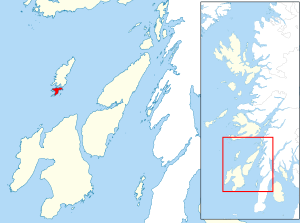Oronsay (Colonsay)
| Oronsay | |
|---|---|
| Oronsay Priory | |
| Waters | Atlantic Ocean |
| Archipelago | Inner Hebrides |
| Geographical location | 56 ° 1 '10 " N , 6 ° 14' 45" W |
| length | 4.6 km |
| width | 2.9 km |
| surface | 5.4 km² |
| Highest elevation | 93 m |
| Residents | 8th (2011) 1.5 inhabitants / km² |
| main place | Oronsay Farm |
| Historical map of Islay ( ILA INSVLA ) with neighboring islands, including Oronsay ( Orvonſa ) | |
Oronsay ( Scottish Gaelic : Orasaigh ) is a small tidal island immediately south of Colonsay , part of the Scottish Inner Hebrides . It is connected to Colonsay by an unpaved dam , which can only be used at low tide and which crosses the mudflats .
Oronsay is 5.4 square kilometers. The highest point is 93 meters high. In 2011, according to the census, there were eight people on the island who live in Oronsay Priory, a small monastery that farms on the island (Oronsay Farm).
Oronsay is separated from the larger island of Colonsay immediately to the north by the mudflat area The Strand , which is between 100 and 1300 meters wide.
Oronsay is an important medium of Stone Age locality with numerous middens ( Caisteal nan Gillean ) of the so-called Obadian . The location of the five Mesolithic mussel heaps shows the months of use of the places, which were derived from the size distribution of the ear bones (otoliths) of coalfish , the most important fish species caught on Oronsay. Because they grow very quickly, the length of the ear bones gives an indication of the time of year the fish was caught.
The island is known for the ruins of the monastery Oronsay , an Augustinian - Abbey from the 14th century. Part of this complex is the stone Celtic Oronsay Great Cross , which is similar to the ones on the island of Iona .
fauna and Flora
Oronsay, in connection with Colonsay, has been a reserve for the dark European bee since 2014 , also because neither bee diseases such as nosemosis or foulbrood nor the varroa mite occur here. The keeping of other bee breeds is prohibited by law in order to protect the purebred.
literature
- Paul Mellars: Excavations in Oronsay. Prehistoric Human Ecology on an small Island. Edinburgh University Press, Edinburgh 1987, ISBN 0-85224-544-0 .
- MP Richards, PA Mellars: Stable isotopes and the seasonality of the Oronsay middens . In: Antiquity. Vol. 72, No. 275, 1998, ISSN 0003-598X , pp. 178-184.
- MP Richards, JA Sheridan: New AMS dates on human bone from Mesolithic Oronsay. In: Antiquity. Vol. 74, No. 284, 2000, pp. 313-315.
Individual evidence
- ↑ 2011 census data
- ↑ Eric McArthur: Independent Beekeepers. In: German bee journal . Vol. 22, No. 9, 2014, p. 32 f.


